
Lorenzo Lotto was an Italian Renaissance painter, draughtsman, and illustrator, traditionally placed in the Venetian school, though much of his career was spent in other north Italian cities. He painted mainly altarpieces, religious subjects and portraits. He was active during the High Renaissance and the first half of the Mannerist period, but his work maintained a generally similar High Renaissance style throughout his career, although his nervous and eccentric posings and distortions represented a transitional stage to the Florentine and Roman Mannerists.

The Holy Family consists of the Child Jesus, the Virgin Mary and Saint Joseph. The subject became popular in art from the 1490s on, but veneration of the Holy Family was formally begun in the 17th century by Saint François de Laval, the first bishop of New France, who founded a confraternity.

Giovanni Cariani, also known as Giovanni Busi or Il Cariani, was an Italian painter of the high-Renaissance, active in Venice and the Venetian mainland, including Bergamo, thought to be his native city.
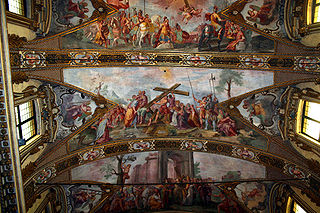
Giovanni Battista Carlone (1603–1684) was an Italian painter of the Baroque period, active mainly in Genoa.
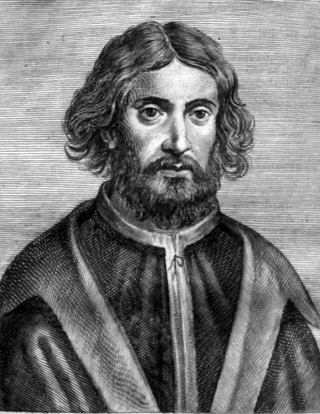
Palma Vecchio, born Jacopo Palma, also known as Jacopo Negretti, was a Venetian painter of the Italian High Renaissance. He is called Palma Vecchio in English and Palma il Vecchio in Italian to distinguish him from Palma il Giovane, his great-nephew, who was also a painter.

The Martinengo Altarpiece is a painting by the Italian High Renaissance painter Lorenzo Lotto, finished in 1516. It is housed in the church of Santi Bartolomeo e Stefano in Bergamo in northern Italy.
Bartolomeo Passante or Bassante was an Italian painter of the Baroque era active in Naples.
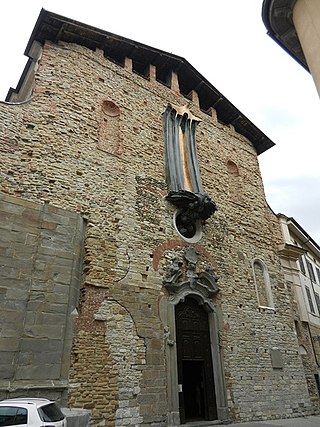
Santo Spirito is a Roman Catholic church located on Piazzetta Santo Spirito in Bergamo, in the region of Lombardy, Italy.

Santa Caterina del Monte di Pietà was a Catholic church in Alcamo, in the province of Trapani.

Mystical Marriage of St Catherine and Saints is an oil-on-panel painting by Lorenzo Lotto, signed and dated 1524, now in the Collections of the Galleria Nazionale d'Arte Antica, Rome, Italy.

Mystical Marriage of St Catherine of Alexandria with Niccoló Bonghi is an oil-on-panel painting by Lorenzo Lotto, executed in 1523, in the Collections of the Accademia Carrara, Bergamo, Italy.

Madonna and Child with Saint Roch and Saint Sebastian is an oil-on-canvas painting by the Italian Renaissance artist Lorenzo Lotto, created c. 1518, now in the National Gallery of Canada, in Ottawa. On the left is Saint Roch and to the right is Saint Sebastian.
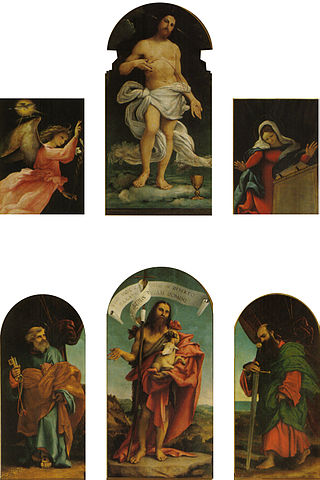
The Ponteranica Altarpiece is a six-panel oil painting series produced by Lorenzo Lotto in 1522, commissioned by the Scuola del Corpo di Cristo for the parish church of San Vincenzo e Sant'Alessandro in Ponteranica, where it still remains. Its upper register shows the risen Christ flanked by an Annunciation scene, whilst below is John the Baptist flanked by saints Peter and Paul.

Portrait of Marsilio Cassotti and His Bride Faustina is an oil-on-canvas painting by Lorenzo Lotto, currently housed in the Museo del Prado, in Madrid. The work, signed and dated "L. Lotus Pictor / 1523", was created during Lotto's stay in Bergamo in 1523. Measuring 71 cm by 84 cm, it represents a significant contribution to the Italian tradition of double portrait marriage paintings, a genre previously more common in Northern Europe.

Count Guglielmo Lochis was an Italian nobleman, politician, art collector and art connoisseur.

Geronimo Gerardi (1595-1648) was a Flemish artist active in Italy. He was born Guilliam Walsgart or Hyeronimus Gerards.

The Suardi Chapel is an oratory or private chapel inside the villa in Trescore Balneario, Province of Bergamo owned by the Suardi counts. It is dedicated to Saint Barbara and Saint Brigid and was completely rebuilt by the cousins Giovan Battista and Maffeo Suardi. It was fully covered in 1524 by frescoes commissioned by them from Lorenzo Lotto of Christ the Vine and Lives of the Saints. In the 19th century, count Gianforte Suardi built a corridor connecting the chapel to the villa and modified the chapel entrance – those entering had previously immediately found themselves in front of the north wall with its depiction of Christ the Vine.

The Oratory of Saint Catherine of Alexandria is a Baroque oratory located attached to the church of Sant'Ignazio all'Olivella, in the quarter of the Castellammare of Palermo, region of Sicily, Italy.

Madonna and Child with Saints is a c. 1520 oil on panel painting by Palma Vecchio, now in room XVI of the Accademia Carrara in Bergamo, the artist's birthplace. It is first recorded as part of the collection of Guglielmo Lochis, who acquired it in 1830 from Cristoforo Orsetti, one of the most important Venetian collectors of that era.
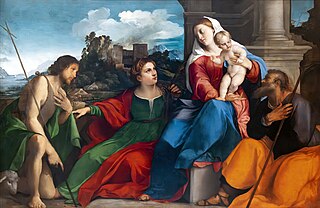
Holy Family with Saint John the Baptist and Saint Catherine is a c. 1520-1528 oil on canvas painting by Palma Vecchio, now in the Gallerie dell'Accademia in Venice. It was completed by Titian after Palma's death.



















